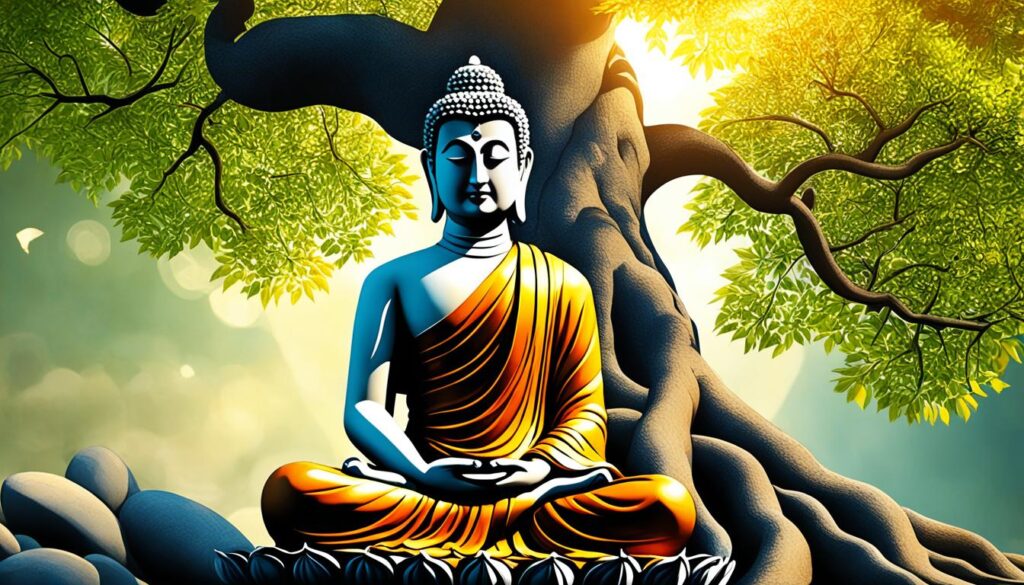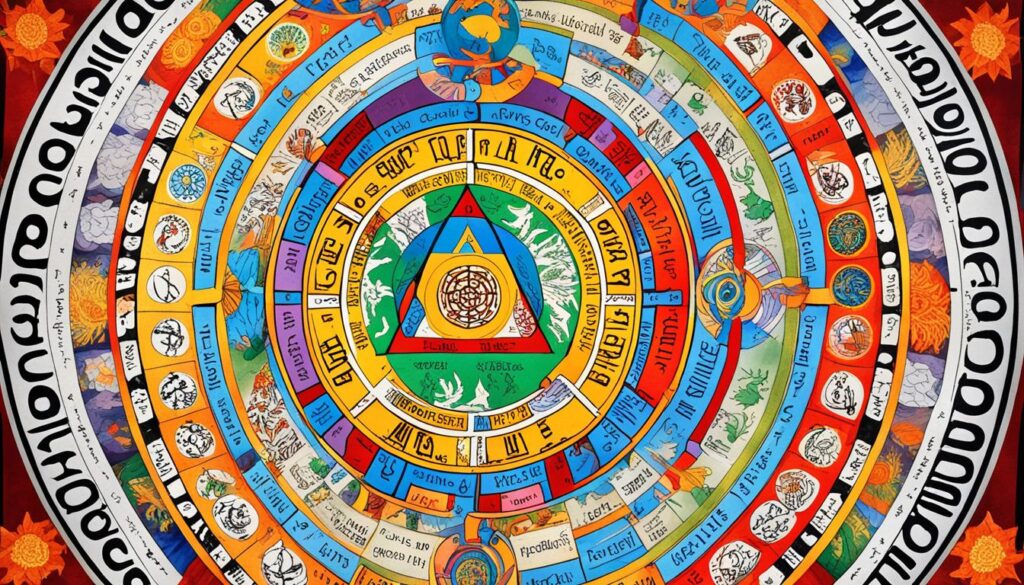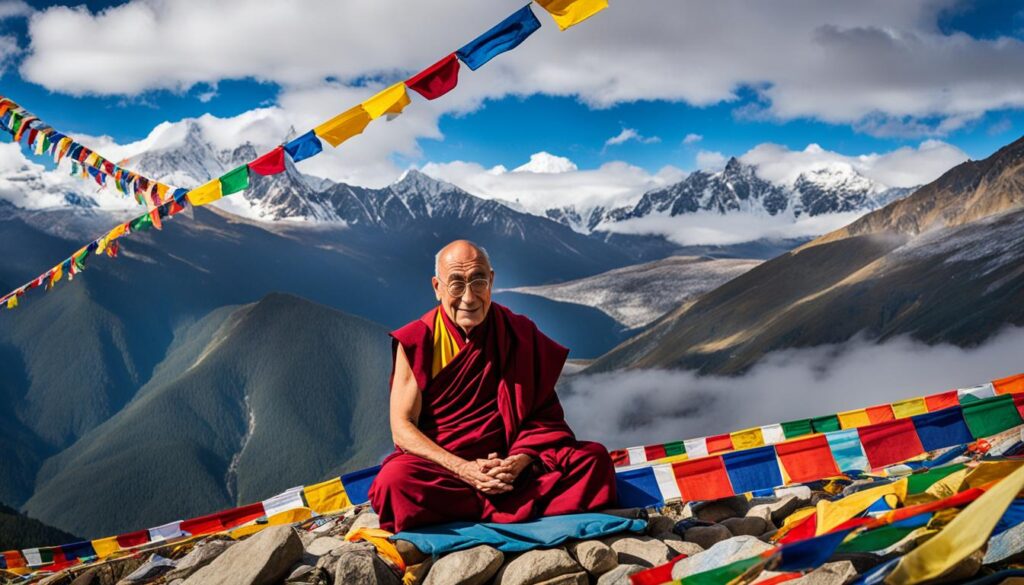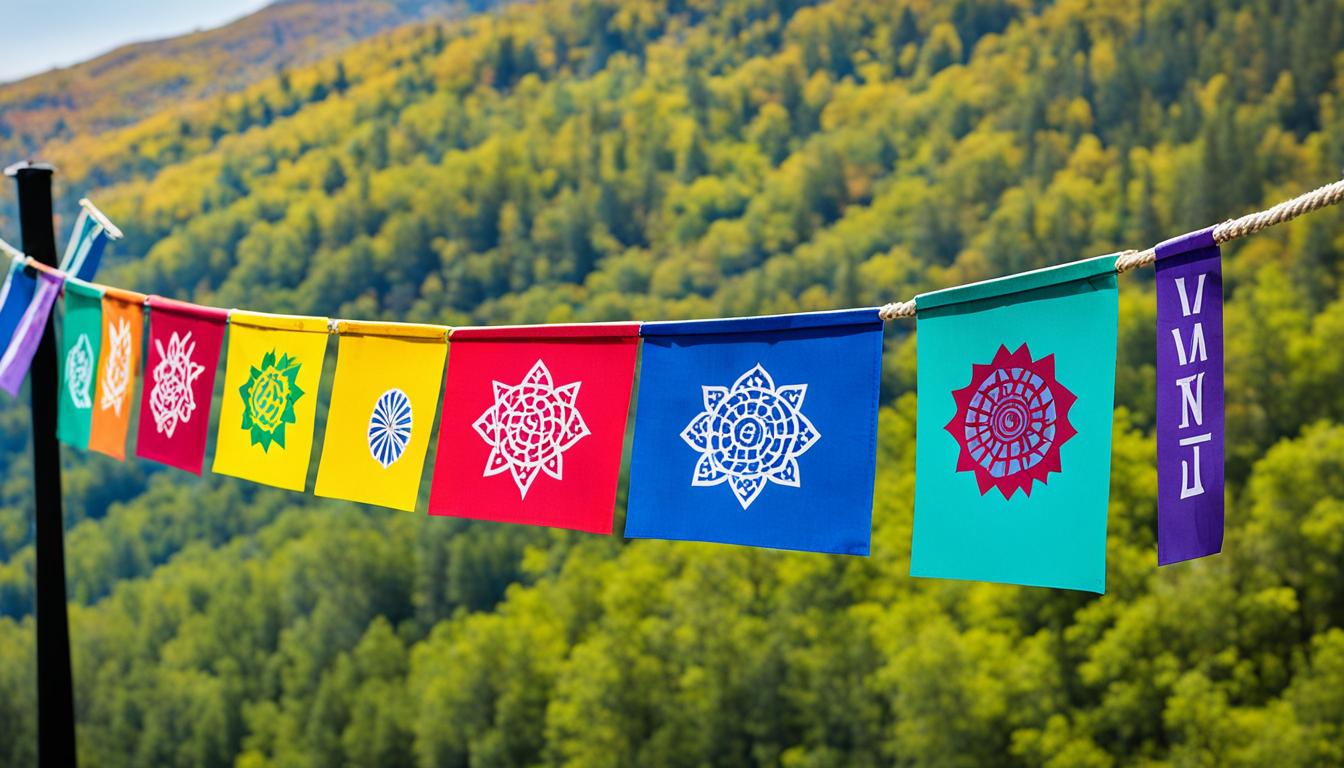“Thousands of candles can be lighted from a single candle, and the life of the candle will not be shortened. Happiness never decreases by being shared.” – Buddha
Welcome to a journey of discovery into the fascinating world of Buddhism beliefs and practices. Buddhism is a profound and ancient religion that offers profound insights into the nature of existence and the human condition. Whether you are seeking spiritual enlightenment, inner peace, or a deeper understanding of life’s complexities, Buddhism offers a rich tapestry of teachings and practices to explore.
Key Takeaways:
- Understand the core beliefs and principles of Buddhism
- Learn about the life of Siddhartha Gautama, the founder of Buddhism
- Discover the Four Noble Truths and the Middle Way
- Explore different schools of Buddhism and their unique practices
- Gain insights into the life and teachings of the Dalai Lama
The Founding of Buddhism and the Life of Siddhartha Gautama

In the early 5th century B.C.E, in present-day Nepal, Siddhartha Gautama was born into a life of luxury and privilege. However, he felt an inner calling to understand the true nature of existence beyond material possessions and earthly desires.
Fueled by a deep sense of curiosity and a profound desire to alleviate human suffering, Siddhartha embarked on a spiritual quest. Leaving behind his opulent lifestyle, he embraced a life of meditation and asceticism in search of enlightenment.
During his quest for truth, Siddhartha Gautama delved into extreme ascetic practices, depriving himself of food and comfort. However, after years of austerity and self-denial, he realized that this path did not lead to the desired awakening. In his own experiences, he discovered that the key to enlightenment lay in balance and moderation.
Embracing what is now known as the Middle Way, Siddhartha Gautama found a path that rejected the extremes of indulgence and self-mortification. This new approach centered around a balanced way of life that harmonized both physical and spiritual well-being.
It was under the shade of the Bodhi tree, in Bodh Gaya, India, that Siddhartha Gautama achieved enlightenment. Following an intense period of meditation and introspection, he experienced profound spiritual awakening. This transformative event led to his recognition as the Buddha, meaning “the awakened one.”
The Middle Way: A Path to Enlightenment
The Middle Way, espoused by Buddha, combines self-discipline, mindfulness, and compassion as the means to transcend suffering and attain enlightenment. It advocates for a balanced approach, avoiding extremes and finding a harmonious middle ground.
The Middle Way guides individuals to navigate life’s challenges, cultivate mindfulness, and embrace compassion for oneself and others. It encourages a holistic approach to growth and transformation while recognizing the interconnectedness of all beings.
| The Founding of Buddhism | The Life of Siddhartha Gautama |
|---|---|
| Born in present-day Nepal | Renounced wealth and pursued meditation |
| Advocated for the Middle Way | Attained enlightenment under the Bodhi tree |
| Became known as the Buddha |
Core Beliefs of Buddhism
Buddhism is centered around several core beliefs that guide the teachings and practices of its followers. These beliefs provide insights into the nature of suffering, the desire that underlies it, the possibility of ending suffering, and the path to achieve enlightenment.
Four Noble Truths:
- Suffering: Buddhism recognizes suffering (dukkha) as an inherent part of human existence. It encompasses physical pain, emotional turmoil, and the unsatisfactory nature of life.
- Desire: According to the Four Noble Truths, the origin of suffering lies in our desires and attachments. Our craving for pleasure, material possessions, and even our attachment to relationships can contribute to our suffering.
- Cessation of Suffering: The good news is that there is a way to end suffering. Buddhism teaches that it is possible to attain a state of liberation and freedom from suffering called enlightenment or nirvana.
- Middle Way: The Middle Way is the path to liberation, offering a balanced approach between extreme self-indulgence and extreme self-mortification. It advocates for moderation, mindfulness, and wise actions to overcome suffering.
Karma and Rebirth:
Buddhists believe in karma, the law of cause and effect. It states that our actions in the past and present influence our future experiences and outcomes. This concept emphasizes personal responsibility and the moral consequences of our choices.
Rebirth, or the cycle of birth and death, is another essential belief in Buddhism. Buddhists believe that when a person dies, their consciousness is reborn into a new body. This cycle continues until one achieves enlightenment and breaks free from the cycle of rebirth.
Buddhist Wheel of Life
To symbolize the interconnectedness of these beliefs and the cycle of existence, Buddhism uses the Wheel of Life. The image below illustrates the various realms, representing different stages in the cycle of rebirth.

| Realm | Description |
|---|---|
| Gods/Devas | Divine beings experiencing great pleasure, but subject to impermanence and eventual rebirth. |
| Humans | Ordinary beings with the potential to pursue enlightenment through virtuous actions. |
| Animals | Beings trapped in ignorance and driven by instinct, often experiencing suffering. |
| Ghosts | Beings tormented by unfulfilled desires and cravings. |
| Hell | Realms of intense suffering for those who have committed grave negative actions. |
The Wheel of Life serves as a visual reminder of the core beliefs of Buddhism and the importance of breaking free from the cycle of suffering through enlightenment.
Schools of Buddhism
Buddhism encompasses various schools and traditions, each with its unique emphasis and practice. These schools provide different paths to spiritual enlightenment and understanding. Let’s explore three prominent schools of Buddhism: Mahayana Buddhism, Theravada Buddhism, and Vajrayana Buddhism.
Mahayana Buddhism
Mahayana Buddhism, meaning “Great Vehicle,” is one of the largest branches of Buddhism. It focuses on the ideal of bodhisattvas — enlightened beings who postpone their own nirvana to assist others in their spiritual journey. Mahayana Buddhism is prevalent in countries such as China, Taiwan, Japan, and South Korea. Bodhisattvas serve as role models, inspiring practitioners to develop compassionate and altruistic qualities.
Theravada Buddhism
Theravada Buddhism, known as the “Teaching of the Elders,” is the oldest surviving branch of Buddhism. It emphasizes the monastic lifestyle and the strict observance of meditation practices. This tradition is prominent in countries like Sri Lanka, Cambodia, Thailand, Laos, and Burma. Theravada Buddhists aim to attain enlightenment through personal discipline, mindfulness, and adherence to the teachings of the Buddha.
Vajrayana Buddhism
Vajrayana Buddhism, also known as Tibetan Buddhism, is practiced primarily in Tibet, Nepal, Bhutan, and Mongolia. It is often regarded as an accelerated path to enlightenment. Vajrayana incorporates various esoteric rituals, elaborate visualizations, and meditation techniques to achieve spiritual transformation. Tantric practices and the worship of deities are integral to Vajrayana Buddhism.
These three schools of Buddhism offer distinct approaches to spiritual growth and enlightenment. While the Mahayana tradition focuses on the compassionate nature of bodhisattvas, Theravada emphasizes the importance of a monastic lifestyle and meditation. Vajrayana Buddhism provides practitioners with powerful methods to attain enlightenment.
Through their diverse teachings and practices, these Buddhist schools contribute to the richness and diversity of the Buddhist tradition.
The Dalai Lama and Tibetan Buddhism
Tibetan Buddhism is deeply intertwined with the figure of the Dalai Lama, who serves as both the spiritual and political leader of Tibet. The Dalai Lama is considered to be an enlightened being, and his teachings and guidance are highly revered by Tibetan Buddhists.
The current Dalai Lama, who is believed to be the 14th reincarnation of Avalokiteshvara, the bodhisattva of compassion, has played a significant role in preserving and promoting Tibetan Buddhism. However, his journey has not been without challenges.
In 1959, the Dalai Lama, then just 24 years old, was forced to flee from Tibet to India due to the Chinese occupation. Since then, he has been living in exile in Dharamshala, India, where he continues to work towards the preservation of Tibetan culture, religion, and autonomy.
Under the Dalai Lama’s leadership, Tibetan Buddhists actively resist Chinese control and advocate for human rights and religious freedom. The Dalai Lama has used his international platform to raise awareness about the situation in Tibet and to promote peace and compassion globally.
However, the future of the Dalai Lama and Tibetan Buddhism remains uncertain. China, which considers the Dalai Lama a separatist, has sought to control the process of appointing his successor. This has led to concerns about the authenticity and legitimacy of future Dalai Lamas.

Despite these challenges, the Dalai Lama’s teachings and the principles of Tibetan Buddhism continue to resonate with people around the world. The Dalai Lama’s message of compassion, non-violence, and inner peace has inspired millions to seek spiritual growth and to make a positive impact in their communities.
Through his tireless efforts, the Dalai Lama has become a symbol of hope, resilience, and the power of spirituality. His teachings serve as a guiding light for those on a journey of self-discovery and enlightenment.
Key Facts about the Dalai Lama and Tibetan Buddhism
| Fact | Details |
|---|---|
| Role of the Dalai Lama | Leader of Tibetan Buddhism and the traditional leader of Tibet |
| Current Dalai Lama | Believed to be the 14th reincarnation, residing in India |
| Challenges | Forced to flee from China-controlled Tibet to India in 1959 |
| Tibetan Resistance | Tibetan Buddhists actively resist Chinese control |
| Future Reincarnation | Uncertain due to Chinese influence and control |
| Teachings and Impact | Inspiring millions with messages of compassion and peace |
Buddhist Beliefs and Practices
As a Buddhist, your beliefs and practices play a significant role in cultivating a mindful and compassionate life. This section explores the key aspects of worship, moral precepts, the Eightfold Path, the Buddhist holy book, and the concept of dharma.
Worship
Buddhists have the freedom to worship in temples or at home, where they create personal altars or meditation spaces. These sacred spaces serve as a focal point for daily rituals and contemplation, allowing you to connect with the divine and deepen your spiritual practice.

Moral Precepts
Moral precepts form the ethical foundation of Buddhist teachings. By adhering to these principles, you cultivate a harmonious and compassionate relationship with yourself and others. The five basic precepts are:
- Refrain from harming living beings
- Refrain from stealing
- Refrain from engaging in sexual misconduct
- Refrain from lying
- Avoid the use of drugs or alcohol
By following these precepts, you create a foundation for virtuous conduct and the cultivation of wholesome intentions.
The Eightfold Path
The Eightfold Path is the roadmap to liberation and the core practice of Buddhism. It guides you towards the cessation of suffering and the attainment of enlightenment. The Eightfold Path consists of the following elements:
- Right understanding
- Right thought
- Right speech
- Right action
- Right livelihood
- Right effort
- Right mindfulness
- Right concentration
Living your life in alignment with these principles allows you to cultivate wisdom, ethical conduct, and mental discipline, leading you closer to the ultimate goal of liberation.
Buddhist Holy Book and Dharma
The Buddhist holy book, known as the Tipitaka, is a vast collection of teachings attributed to the Buddha. It contains discourses, rules for monastic discipline, and philosophical expositions. The Tipitaka provides guidance for understanding the nature of reality, the causes of suffering, and the path to enlightenment.
The concept of dharma is central to Buddhism. It refers to the natural laws and principles that govern the universe and human existence. Understanding and aligning oneself with the dharma is essential for finding meaning, purpose, and harmony in life.
By embracing these beliefs and engaging in these practices, you can deepen your understanding of Buddhism and cultivate a life of wisdom, compassion, and liberation.
Conclusion
Buddhism offers a spiritual path to cultivate mindfulness, compassion, and personal growth. Its beliefs and practices provide guidance for navigating the challenges of life and finding inner peace. By understanding the core teachings of Buddhism, individuals can gain insights into themselves and the world around them.
At the heart of Buddhism are principles such as the Four Noble Truths, which shed light on the nature of suffering and the path to liberation. Through meditation and self-reflection, individuals can develop a deeper understanding of their desires and attachments, and learn to let go of them, ultimately reducing suffering in their lives.
Buddhist practices, such as following moral precepts, engaging in meditation, and living in accordance with the Eightfold Path, help seekers develop mindfulness and compassion. These practices encourage self-awareness, empathy towards others, and the cultivation of virtues such as kindness, generosity, and patience.
By embracing the teachings of Buddhism, individuals can embark on a transformative journey towards self-discovery and personal growth. Through the practice of mindfulness and the development of compassion, individuals can not only find inner peace but also foster harmonious relationships and contribute to the greater well-being of humanity.
FAQ
What is Buddhism?
Buddhism is a major world religion that originated in South Asia around the 5th century B.C.E. It is based on the teachings of Siddhartha Gautama, also known as the Buddha, and emphasizes the cycle of suffering and rebirth, with the ultimate goal of achieving enlightenment (nirvana) to escape this cycle.
Who was Siddhartha Gautama?
Siddhartha Gautama was the founder of Buddhism. He was born in present-day Nepal and renounced his wealth to pursue a life of meditation and asceticism. After realizing that extreme asceticism did not lead to enlightenment, he advocated for the Middle Way and achieved enlightenment under the Bodhi tree, becoming known as the Buddha.
What are the core beliefs of Buddhism?
The core beliefs of Buddhism revolve around the Four Noble Truths, which teach about the nature of suffering, its origin in desire, the possibility of ending suffering, and the path to achieve enlightenment. Buddhists also believe in karma, which connects actions in past and present lives to future outcomes, and in rebirth into different bodies.
What are the different schools of Buddhism?
Buddhism is practiced in different schools. Mahayana Buddhism emphasizes bodhisattvas as role models and is common in China, Taiwan, Japan, and South Korea. Theravada Buddhism emphasizes a monastic lifestyle and meditation and is prevalent in Sri Lanka, Cambodia, Thailand, Laos, and Burma. Vajrayana Buddhism offers a faster path to enlightenment and is practiced in Tibet, Nepal, Bhutan, and Mongolia.
Who is the Dalai Lama and what is his significance in Tibetan Buddhism?
The Dalai Lama is the leader of Tibetan Buddhism and the traditional leader of Tibet. The current Dalai Lama, believed to be the 14th reincarnation, fled from China-controlled Tibet to India in 1959. Tibetan Buddhists actively resist Chinese control, and the future reincarnation of the Dalai Lama is uncertain.
What are some of the beliefs and practices in Buddhism?
Buddhists can worship in temples or at home. They follow a set of moral precepts that prohibit harming living beings, stealing, sexual misconduct, lying, and the use of drugs or alcohol. The Eightfold Path, consisting of right understanding, thought, speech, action, livelihood, effort, mindfulness, and concentration, is the path to liberation. Buddhist sacred texts include the Tipitaka, Sutras, and the Book of the Dead.

